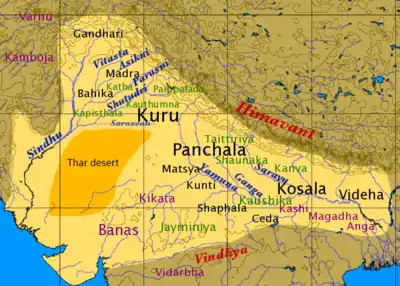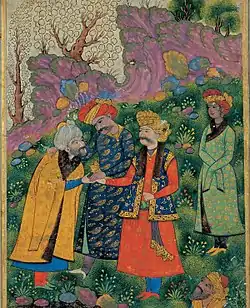Punjabi Muslims
Punjabi Muslims (Punjabi: پنجابی مسلمان (Shahmukhi)) are a linguistic, geographic and religious ethnic group living in the region of Punjab, primarily in Pakistan. Forming the majority of the Punjabi ethnicity,[8] Punjabi Muslims are those who profess Islam and speak or identify the Punjabi language (under the Shahmukhi script) as a mother tongue. With a population of more than 90 million[9] they are the largest ethnic group in Pakistan and the world's third largest Muslim ethnicity,[10] after Arabs,[11] and Bengalis[12] The majority of Punjabi Muslims are adherents of the Sunni branch of Islam. A minority adheres to Shia and other sects, including the Ahmadiyya community which originated in Punjab.
پنجابی مسلمان | |
|---|---|
| Regions with significant populations | |
| 95,095,957 estimated[1] | |
| 500,000[2] | |
| 300,000 est. | |
| 263,699[3] | |
| 200,000 est. | |
| 100,310[4] | |
| 43,000[5] | |
| 25,000[6] | |
| 19,408 est. | |
| 13,000[7] | |
| Languages | |
| Punjabi and its dialects, Arabic (liturgical), Urdu and English | |
| Religion | |
| Islam 100% (majority Sunni, while 5% being Shia) | |
| Part of a series on |
| Punjabis |
|---|
 |
|
Punjab portal |
The homelands of Punjabi Muslims are mainly concentrated in the Pakistani province of Punjab. They have a worldwide diaspora, with significant communities in North America and the United Kingdom and large expatriate populations in the Middle East.
Punjab literally means the 'land of five waters' (Persian: punj ("five") āb ("waters")). Punjab is often referred to as the breadbasket in Pakistan.[13][14]
The coalescence of the various tribes, castes and the inhabitants of the Punjab into a broader common "Punjabi" identity initiated from the onset of the 18th century CE. Prior to that the sense and perception of a common "Punjabi" ethno-cultural identity and community did not exist, even though the majority of the various communities of the Punjab had long shared linguistic, cultural and racial commonalities.[15][16][17]
History
Ancient history

Punjab during Mahabharata times was known as Panchanada.[18][19] Punjab was part of the Indus Valley Civilization, more than 5000 years old.[20] The main site in Punjab was the city of Harrapa. The Indus Valley Civilization spanned much of what is today Pakistan and eventually evolved into the Indo-Aryan civilization. The arrival of the Indo-Aryans led to the flourishing of the Vedic civilization along the length of the Indus River. This civilization shaped subsequent cultures in South Asia and Afghanistan. Although the archaeological site at Harappa was partially damaged in 1857 when engineers constructing the Lahore-Multan railroad used brick from the Harappa ruins for track ballast, an abundance of artifacts have nevertheless been found. Punjab was part of the great ancient empires including the Gandhara Mahajanapadas, Achaemenids, Macedonians, Mauryas, Kushans, Guptas, Hindu Shahi, Gurjara-Pratihara and old Rajputana.[21][22][23] Agriculture flourished and trading cities (such as Multan and Lahore) grew in wealth.

Due to its location, the Punjab region came under constant attack and influence from the west and witnessed centuries of foreign invasions by the Greeks, Kushans, Scythians, Turks, Arabs, and Afghans. The city of Taxila, claimed to have been founded by Taksh the son of Bharat who was the brother of Ram. It was reputed to house the oldest university in the world, Takshashila University. One of the teachers was the great Vedic thinker and politician Chanakya. Taxila was a great centre of learning and intellectual discussion during the Maurya Empire. It is a UN World Heritage site, valued for its archaeological and religious history.
Central Asian, Greek, and Persian Empires

The northwestern part of the South Asia, including Punjab, was repeatedly invaded or conquered by various foreign empires, such as those of Tamerlane, Alexander the Great and Genghis Khan. Having conquered Drangiana, Arachosia, Gedrosia and Seistan in ten days, Alexander crossed the Hindu Kush and was thus fully informed of the magnificence of the country and its riches in gold, gems and pearls. However, Alexander had to encounter and reduce the tribes on the border of Punjab before entering the luxuriant plains. Having taken a northeasterly direction, he marched against the Aspii (mountaineers), who offered vigorous resistance, but were subdued. Alexander then marched through Ghazni, blockaded Magassa, and then marched to Ora and Bazira. Turning to the northeast, Alexander marched to Pucela, the capital of the district now known as Pakhli. He entered Western Punjab, where the ancient city of Nysa (at the site of modern-day Mong) was situated. A coalition was formed against Alexander by the Cathians, the people of Multan, who were very skillful in war. Alexander invested many troops, eventually killing seventeen thousand Cathians in this battle, and the city of Sagala (present-day Sialkot) was razed to the ground. Alexander left Punjab in 326 B.C. and took his army to Persia and Susa.
Arrival of Islam

The Punjabis followed a diverse plethora of faiths, mainly Hinduism and Buddhism until the Arab Umayyad army brought Islam to the region led by Muhammad bin Qasim who conquered Sindh and Southern Punjab in 712, by defeating Raja Dahir. The Umayyad Caliphate was the second Islamic caliphate established after the death of Muhammad. It was ruled by the Umayyad dynasty, whose name derives from Umayya ibn Abd Shams, the great-grandfather of the first Umayyad caliph.
Islam was introduced into Northern Punjab during the reign of Mahmud of Ghazni in the 11th century and the region subsequently became part of various Turco-Persian and Turco-Mongol Muslim empires.
The Ghaznavids had earlier conquered and converted many Hindu-Buddhist kingdoms of Afghanistan. The province of Punjab was made part of the Ghaznavid Empire with Lahore as its second capital. The region became predominantly Muslim due to missionary Sufi saints whose dargahs dot the landscape of the Punjab region. The famous Sufi mystic Hazrat Ali Hujwiri arrived from Ghazni and settled in Lahore during the reign of Ghaznavids in 11th century.
Over the next millennium Islam flourished in Punjab as it became part of different Muslim empires including the Ghurids, Delhi Sultanate and Mughals. In cooperation with local Punjabi tribes and others, a millennium long Islamic dominance was achieved across South Asia and with its peak during the Mughal Empire.
Indian historian Rajmohan Gandhi says that conversions to Islam in Punjab were justified by multiple factors, like the missionary activities of the Sufis, the fact that tribes like Jats or Gujjars weren't absorbed into the Hindu caste system or that Dalits tried to precisely escape it.[24]
Mughal Empire
The Mughals controlled the region from 1524 until around 1739 and implemented building projects which remain iconic landmarks of the Punjab such as the Shalimar Gardens and the Badshahi Mosque, both situated in Lahore. Muslim soldiers, traders, architects, theologians and Sufis came from the rest of the Muslim world to the empire. The last Muslim ruler to control the Punjab was the Afghan conqueror Ahmad Shah Durrani who made the Punjab a part of his Durrani Empire lasting until 1762.[25]
Independence
In 1947 the Punjab province of British India was divided along religious lines into West Punjab and East Punjab. Western Punjab was assimilated into the new country of Pakistan, while East Punjab became a part of modern-day India. This led to massive rioting as both sides committed atrocities against fleeing refugees.
Punjab (Pakistan), which once formed a major region of British Punjab, was home to a large minority population of Punjabi Sikhs and Hindus up to 1947 apart from the Muslim majority.[26]
Migration between India and Pakistan was continuous before independence. By the 1900s Western Punjab was predominantly Muslim and supported the Muslim League and Pakistan Movement. After independence, the minority Hindus and Sikhs migrated to India while Muslim refugees from India settled in the Western Punjab and across Pakistan.[27]
Recent history

Since the 1950s, Punjab industrialized rapidly. New factories were established in Lahore, Gujrat, Gujranwala, Sialkot and Wah. In the 1960s, the new city of Islamabad was founded north of Rawalpindi.
Agriculture continues to be the largest sector of Punjab's economy. The province is the breadbasket of the country as well as home to the largest ethnic group in Pakistan, the Punjabis. Unlike neighbouring India, there was no large-scale redistribution of agricultural land. As a result, most rural areas are dominated by a small set of feudalistic land-owning families.
In the 1950s there was tension between the eastern and western halves of Pakistan. In order to address the situation, a new formula resulted in the abolition of the province status for Punjab in 1955. It was merged into a single province West Pakistan. In 1972, after East Pakistan seceded and became Bangladesh, Punjab again became a province.
Punjab witnessed major battles between the armies of India and Pakistan in the wars of 1965 and 1971. Since the 1990s Punjab hosted several key sites of Pakistan's nuclear program such as Kahuta. It also hosts major military bases such as at Sargodha and Rawalpindi. The peace process between India and Pakistan, which began in earnest in 2004, has helped pacify the situation. Trade and people-to-people contacts through the Wagah border are now starting to become common. Indian Sikh pilgrims visit holy sites such as Nankana Sahib.
Starting in the 1980s, large numbers of Punjabis migrated to the Middle East, Britain, Spain, Canada and the United States for economic opportunities, forming the large Punjabi diaspora. Business and cultural ties between the United States and Punjab are growing. Also, there are many Punjabi Muslims in India living a quiet and happy life in a minority population, most of them are in the city of Malerkotla.
See also
- Punjabi people
- Islam in Pakistan
- Punjabi Christians
- Punjabi Sikhs
- Punjabi Hindus
- Shahmukhi alphabet, the script used by Punjabi Muslims to read and write Punjabi
Notes
References
- 2020 CIA World Fact Book, Pakistan
- Nadia Mushtaq Abbasi. "The Pakistani Diaspora in Europe and Its Impact on Democracy Building in Pakistan" (PDF). International Institute for Democracy and Electoral Assistance. p. 5. Archived from the original (PDF) on 22 December 2010. Retrieved 9 November 2020.
- "American Pakistan Foundation Ready To Engage Pakistani Diaspora". Archived from the original on 29 November 2014. Retrieved 9 November 2020. (US Embassy, Islamabad Report)
- "Ethnic Origin (264), Single and Multiple Ethnic Origin Responses (3), Generation Status (4), Age Groups (10) and Sex (3) for the Population in Private Households of Canada, Provinces, Territories, Census Metropolitan Areas and Census Agglomerations, 2011 National Household Survey".
- http://www.index.go.kr/egams/stts/jsp/potal/stts/PO_STTS_IdxMain.jsp?idx_cd=2756
- http://kosis.kr/statisticsList/statisticsList_01List.jsp?vwcd=MT_ZTITLE&parentId=A
- http://www.immigration.go.kr/HP/COM/bbs_003/ListShowData.do?strNbodCd=noti0096&strWrtNo=124&strAnsNo=A&strOrgGbnCd=104000&strRtnURL=IMM_6050&strAllOrgYn=N&strThisPage=1&strFilePath=imm
- Gandhi, Rajmohan (2013). Punjab: A History from Aurangzeb to Mountbatten. New Delhi, India, Urbana, Illinois: Aleph Book Company. p. 1. ISBN 978-93-83064-41-0.
- Gandhi, Rajmohan (2013). Punjab: A History from Aurangzeb to Mountbatten. New Delhi, India, Urbana, Illinois: Aleph Book Company. p. 1. ISBN 978-93-83064-41-0.
- Gandhi, Rajmohan (2013). Punjab: A History from Aurangzeb to Mountbatten. New Delhi, India, Urbana, Illinois: Aleph Book Company. p. 2. ISBN 978-93-83064-41-0.
- Margaret Kleffner Nydell Understanding Arabs: A Guide For Modern Times, Intercultural Press, 2005, ISBN 1931930252, page xxiii, 14
- roughly 152 million Bengali Muslims in Bangladesh and 36.4 million Bengali Muslims in the Republic of India (CIA Factbook 2014 estimates, numbers subject to rapid population growth); about 10 million Bangladeshis in the Middle East, 1 million Bengalis in Pakistan, 5 million British Bangladeshi.
- "Punjab, bread basket of India, hungers for change". Reuters. January 30, 2012.
- "Columbia Water Center Released New Whitepaper: "Restoring Groundwater in Punjab, India's Breadbasket" – Columbia Water Center". Water.columbia.edu. 2012-03-07. Retrieved 10 November 2020.
- Malhotra, edited by Anshu; Mir, Farina (2012). Punjab reconsidered : history, culture, and practice. New Delhi: Oxford University Press. ISBN 9780198078012.CS1 maint: extra text: authors list (link)
- Ayers, Alyssa (2008). "Language, the Nation, and Symbolic Capital: The Case of Punjab" (PDF). Journal of Asian Studies. 67 (3): 917–46. doi:10.1017/s0021911808001204.
- Thandi, edited and introduced by Pritam Singh and Shinder S. (1996). Globalisation and the region : explorations in Punjabi identity. Coventry, United Kingdom: Association for Punjab Studies (UK). ISBN 1874699054.CS1 maint: extra text: authors list (link)
- Gazetteer of the Bombay Presidency ... – Google Books
- Gazetteer of the Bombay Presidency ..., Volume 1, Part 1-page-11
- Punjab History – history of Punjab
- "The Gurjara-Pratihara empire, comprising the territories stretching between Bihar, the Panjab and Kathiawar, was the last great pre-Muslim empire of north India." (Ronald Stuart McGregor: A History of Indian Literature. Page 03) Website: https://books.google.com/books?id=SGsOGT8Xej8C&pg=PA3&dq=gurjara-pratihara+punjab&hl=en&sa=X&ei=9N7IU-TgF4mZyAS2rYK4Aw&ved=0CEYQ6AEwCA#v=onepage&q=gurjara-pratihara%20punjab&f=false
- "The best known ruler of the dynasty was Bhoja, who enjoyed a long reign of half a century (A.D. 840-890). During his reign the Gurjara-Pratiharas became an imperial power controlling Eastern Punjab, Rajasthan, Uttar Pradesh, and parts of Madhya Pradesh and Saurashtra. (Balkrishna Govind Gokhale, Ancient India: History and Culture. Page.84) Website: https://books.google.com/books?id=AOiBLjroszoC&pg=PA84&dq=gurjara-pratihara+punjab&hl=en&sa=X&ei=q8jIU7DFOJCXyAS8mILAAw&ved=0CBsQ6AEwAA#v=onepage&q=gurjara-pratihara%20punjab&f=false
- "1. They are also called Gurjara-Pratihara. 2. They established their sway over Punjab, Malwas and Broach." Study Package For Clat By Bharadwaj. .... https://books.google.com/books?id=ZeJ-8Xhj17MC&pg=SL2-PA19&dq=gurjara-pratihara+punjab&hl=en&sa=X&ei=9N7IU-TgF4mZyAS2rYK4Aw&ved=0CCYQ6AEwAg#v=onepage&q=gurjara-pratihara%20punjab&f=false
- Rajmohan Gandhi, Punjab: A History from Aurangzeb to Mountbatten, Rupa, 2015, chapter 1
- Runion, Meredith L. (2007). The History of Afghanistan. ISBN 9780313337987. Retrieved 20 March 2015.
- The Punjab in 1920s – A Case study of Muslims, Zarina Salamat, Royal Book Company, Karachi, 1997. table 45, pp. 136. ISBN 969-407-230-1
- Dube, I. &. S. (2009). From ancient to modern: Religion, power, and community in India hardcover. Oxford University Press.
